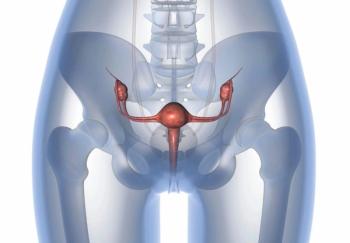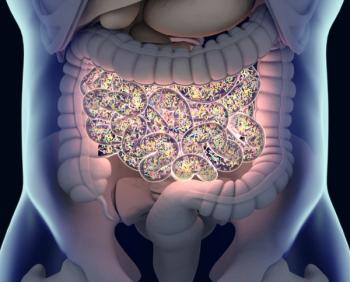
Voruciclib Regimens Demonstrate Preliminary Potency Against KRAS-Positive Cancers
The early results showed that voruciclib led to a rapid decrease in the phosphorylation of proteins that promote MYC transcription and quickly decreases phosphorylation of MYC protein on Serine 62 (Ser62), which is a site implicated in stabilizing MYC in KRAS-mutant cancers.
Treatment with voruciclib, a CDK9 inhibitor, as a monotherapy or in combination with sotorasib (AMG 510) and adagrasib demonstrated early activity in KRAS-mutant cancer cell lines, and synergistically inhibited growth of KRAS-mutant cancers in preclinical models, according to findings presented during Week 1 of the 2021 AACR Virtual Annual Meeting.1,2
The early results showed that voruciclib led to a rapid decrease in the phosphorylation of proteins that promote MYC transcription and quickly decreases phosphorylation of MYC protein on Serine 62 (Ser62), which is a site implicated in stabilizing MYC in KRAS-mutant cancers.
“Voruciclib demonstrated single-agent efficacy against multiple KRAS-mutant cancer cell lines and acted synergistically with KRAS G12C inhibitors in both in vitro and in vivo models,” Sandra Wiley, MD, of MEI Pharma, the developer of the CDK9 inhibitor, said in a virtual presentation of the data. “Collectively, these experiments suggest that voruciclib could be an attractive therapeutic option for cancers driven by KRAS-MYC.”
Voruciclib is an oral small molecular inhibitor of CDK 9, 4, 6, and 1 that is currently being evaluated in a phase 1b trial of patients with B-cell malignancies and acute myeloid leukemia. Although the study presented during the 2021 AACR Annual Meeting focused on the activity of the agent in KRAS-mutant cancers, its effect on MYC regulation is “at the heart of the story,” Wiley said.
CDK9 is an integral part of the PTEFb complex that regulates RNA polymerase II. Upon initiation of transcription, RNA polymerase II is subject to promote proximal pausing. After release from an inhibitory complex, PTEFb interacts with the polymerase II complex and phosphorates proteins that relieve pausing and allow for productive elongation.
In AML models, voruciclib inhibition of CDK9 leads to decreased expression of RNA polymerase II transcriptional targets, including MYC and MCL1. Furthermore, KRAS mutations are often complemented by stabilization by the MYC oncoprotein. Signaling through the RAS/RAF/MEK pathway leads to ERK1 phosphorylation of MYC on Ser62. Recent reports have shown that CDK9 can also directly phosphorylate MYC on Ser62 and may regulate MYC protein stability, in addition to MYC transcription.
For this study, investigators sought to determine whether voruciclib could acutely affect proteins that regulate RNA pol II activity in KRAS-mutant solid tumor models. Through the use of a phosphoproteomics approach, researchers utilized MIA PaCa-2 cells in a pancreatic cancer line with a KRAS G12C mutation.
Investigators noted that there was “good coverage and detected hundreds of proteins with a decrease in phosphorylation after voruciclib treatment. Consistent with a role in inhibition of PETfb, after exposure to voruciclib, there was a rapid downregulation of RNA polymerase II–associated proteins that control MYC transcription,” Wiley explained.
Additionally, an immunoblot analysis with a phosphor-specific antibody revealed that voruciclib led to a rapid inhibition of phosphorylation of MYC on Ser62. Here, data showed that there was a 60% decrease of Ser62 phosphorylation at 5 minutes was observed that reached 80% by 60 minutes. However, there was no decrease in total MYC proteins at either time point. However, there was a reduction in total MYC at 60 minutes that reached 50% at 240 minutes.
This is consistent with Ser62 de-phosphorylation promoting MYC protein instability and degradation, Wiley noted.
Furthermore, voruciclib was found to inhibit proliferation of KRAS-mutant cancer cell lines in vitro and in vivo. Through an in vitro assay tested 22 cancer cell lines harboring multiple KRAS mutations—including G12D, G12V, G12C, G12A, G12S, Q61H, G13C—results showed that voruciclib “decreased viability in all cell lines tested with low micromolar IC50s [half maximal inhibitory concentration],” Wiley said.
Additionally, voruciclib was found to inhibit tumor growth in vivo in KRAS-mutant colorectal cancer and lung cancer xenograft models.
Regarding combination strategies with voruciclib, investigators hypothesized that the CDK9 inhibitor may have synergy with the KRAS G12C inhibitors sotorasib and adagrasib. By measuring growth inhibition in a panel of KRAS-mutant cell lines treated with voruciclib in combination with each agent, synergy was observed in most of the cell lines harboring KRAS G12C mutations.
Stemming from this activity, researchers also examined the synergy of voruciclib with sotorasib in an in vivo MIA PaCA-2 tumor model utilizing Presage CIVO technology, which involved in vivo intratumoral injection of the compound, followed by immunohistochemistry testing. Similar testing was conducted with adagrasib, Wiley noted.
“Collectively, the data reported today offer the opportunity to expand our current development activities with voruciclib and support its potential as a therapeutic option for KRAS mutated cancers in combination with direct inhibitors of KRAS,” Daniel P. Gold, PhD, president and chief executive officer of MEI Pharma, said in a statement. “Beyond these data, we have ongoing efforts to explore other potential synergistic combinations in various KRAS-mutated cancers as we evaluate opportunities to confirm these findings in a clinical setting.”
References
- Wiley S, Su Y, Ge Y. Voruciclib, a CDK9 inhibitor, downregulates MYC and inhibits proliferation of KRAS mutant cancers in preclinical models. Presented at: 2021 AACR Annual Meeting 2021; April 10-15, 2021; Virtual. Abstract 1962.
- MEI Pharma reports preclinical data demonstrating ability of voruciclib to regulate myc and synergize with KRAS inhibitors in KRAS mutant cancers. News release. MEI Pharma. Published April 10, 2021. Accessed April 10, 2021.
Newsletter
Stay up to date on recent advances in the multidisciplinary approach to cancer.



















































































